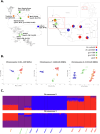Population genomic evidence of a putative 'far-west' African cryptic taxon in the Anopheles gambiae complex
- PMID: 39256556
- PMCID: PMC11387608
- DOI: 10.1038/s42003-024-06809-y
Population genomic evidence of a putative 'far-west' African cryptic taxon in the Anopheles gambiae complex
Abstract
The two main Afrotropical malaria vectors - Anopheles coluzzii and An. gambiae - are genetically distinct and reproductively isolated across West Africa. However, populations at the western extreme of their range are assigned as "intermediate" between the two species by whole genome sequence (WGS) data, and as hybrid forms by conventional molecular diagnostics. By exploiting WGS data from 1190 specimens collected across west Africa via the Anopheles gambiae 1000 Genomes network, we identified a putative taxon in the far-west (provisionally named Bissau molecular form), which did not arise by admixture but rather may have originated at the same time as the split between An. coluzzii and An. gambiae. Intriguingly, this taxon lacks insecticide resistance mechanisms commonly observed in the two main species. These findings lead to a change of perspective on malaria vector species in the far-west region with potential for epidemiological implications, and a new challenge for genetic-based mosquito control approaches.
© 2024. The Author(s).
Conflict of interest statement
The authors declare no competing interests.
Figures





Update of
-
Speciation within the Anopheles gambiae complex: high-throughput whole genome sequencing reveals evidence of a putative new cryptic taxon in 'far-west' Africa.Res Sq [Preprint]. 2024 Mar 18:rs.3.rs-3914444. doi: 10.21203/rs.3.rs-3914444/v1. Res Sq. 2024. Update in: Commun Biol. 2024 Sep 10;7(1):1115. doi: 10.1038/s42003-024-06809-y. PMID: 38562903 Free PMC article. Updated. Preprint.
References
-
- Powell, J. R., Petrarca, V., della Torre, A., Caccone, A. & Coluzzi, M. Population structure, speciation, and introgression in the Anopheles gambiae complex. Parassitologia41, 101–113 (1999). - PubMed
MeSH terms
Grants and funding
LinkOut - more resources
Full Text Sources

